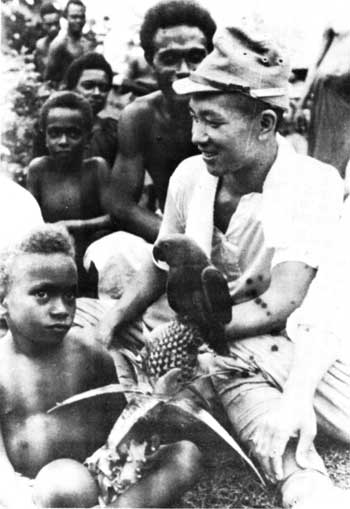| The War in the Pacific |
|
|
PACIFIC ENCOUNTERS: ENCOUNTERS Wartime encounters threatened established symbols of separation and inequality. Prewar norms required distinctly different styles of conduct and dress for Europeans and Islanders. These differences served to maintain boundaries between colonizer and colonized. But, with the war, every encounter between Islanders and military newcomers threatened to violate these boundaries and the code of European superiority. Every time an Islander and soldier did the same job, ate the same food, played the same game, wore the same clothes, or addressed each other with the same term ("Joe" or "mate"), the established code was violated. Colonial Attitudes In Papua New Guinea, efforts of long-time white residents to maintain prewar relations with "natives" were codified in a 1943 booklet written by an Australian officer for the Southwest Pacific Allied Command: You and the Native: Notes for the Guidance of Members of the Forces in their Relations with New Guinea Natives. Several of the 100 points of advice give a clear picture of prewar attitudes:
But the Australian, New Zealander and American soldiers who came to fight a war cared little for these dictates. Many objected to the petty treatment of men who were fighting alongside them and saving the lives of wounded mates. The situation in Papua New Guinea between colonial authorities and army troops was paralleled closely in the Solomon Islands. British authorities responsible for administering the Labour Corps urged the U.S. commander on Guadalcanal to issue the following memorandum:
The stories told by veterans of the Solomon Islands Labour Corps indicate that the British authorities did indeed have a problem on their hands. Jonathan Fifi'i, leader of a Labour Corps section on Guadalcanal, remembers the deep impression made by friendly encounters with Americans.
Black Americans The sight of Black American soldiers wearing the same uniforms and performing many of the same roles as white soldiers carried a social message for black (Melanesian) Islanders. Approximately 200,000 black U.S. military personnel served in the Far East and the Pacific. Since many were in service units (quartermasters, Seabees), they had considerable contact with island labor forces. Apparently the structured segregation of World War II forces left much less of an impression on island memories than the obvious abilities and achievements of Black Americans.
Eating For most Pacific Islanders, sharing food is a sign of closeness and trust. Exclusion from the tables of colonial "masters," except to wait on them, had always been an emblem of social distance and servitude. In contrast, servicemen from both sides found it natural and appropriate to share meals with their island "hosts." Jack Boland, a member of the Australian 39th Battalion remembers,
Learning In addition to learning about modern warfare or work routines, Islanders also acquired a much fuller understanding of the cultures of Westerners and Japanese—their music, food, sports, politics, and language. For their part, Islanders taught curious newcomers (admittedly, many were not curious) about "custom": how to dance, weave thatch, make fire with sticks, make string-figures and the like. Early in the war, the Japanese increased opportunities for advanced education in Micronesia, and also set up elementary schools in Bougainville and along the north coast of Papua New Guinea. In Belau (Palau), where people had been much more immersed in Japanese language and culture through 30 years of their colonial rule, a song composed at the end of the war laments:
Mainichi Shimbun
Ceremonies Since villages were usually off-limits, visits by invited military personnel often became ceremonial occasions for villagers to display their traditions in context, and to use those traditions to define new relationships. Again and again military delegations were welcomed with mock attacks, elaborate handshaking or hymn-singing, feasted with sumptuous stocks of food, presented with gifts, and entertained with dancing and singing into the night. For the warring armies, the most potent customs and ceremonies were those symbolizing the identity of nations and cultures they were fighting for. The Japanese in Belau exhorted the local populace to gather for morning worship in homage to the Emperor in Tokyo. These ceremonies included patriotic speeches, singing the national anthem, and repeating an oath to the Emperor. As U.S. forces occupied Micronesia, they replaced this with flag-raisings and their pledge of allegiance. |
